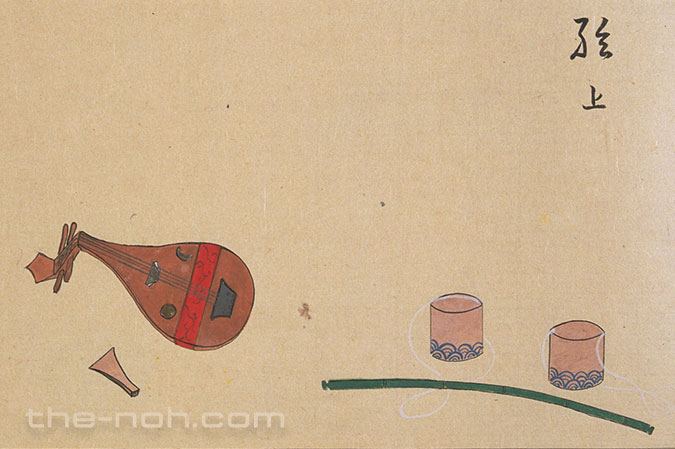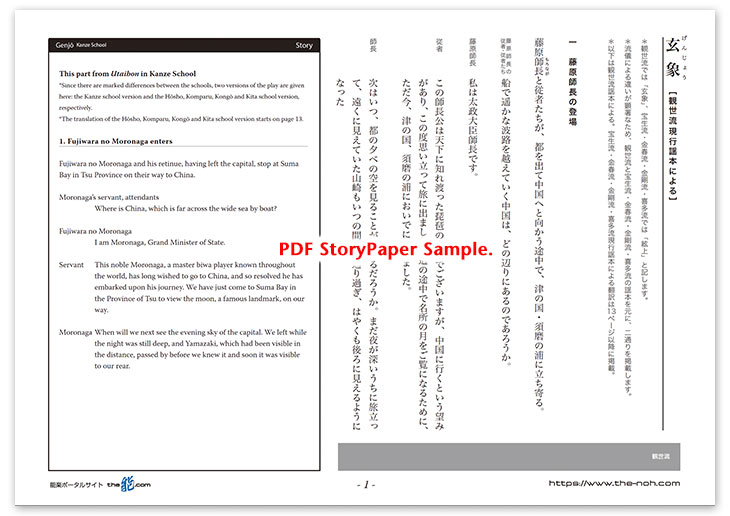
 Genjō / Kenjō
Genjō / Kenjō

![]()
Fujiwara no Moronaga, a virtuoso biwa (Japanese lute) player, believing that there is no equal for him in Japan, resolves to travel to China seeking to master the secrets of the instrument. Leaving the capital, he arrives on the Suma coast in Tsu Province (or Sesshu) where he meets an elderly couple who let him stay at their house overnight. At the request of the elderly couple Moronaga plays the biwa, but he ceases his performance when a passing shower begins to fall. The elderly couple brings rush mats to thatch the shingle-roofed house so as to harmonize the tone of the melody with the sound of the rain hitting the shingle. Surprised by the couple’s attentiveness, Moronaga asks them to play a piece, at which, the old man and the old woman begin to play ‘Etenraku’ (literally, music brought from heaven; a Japanese gagaku melody and dance) in concert on the biwa and koto (a long Japanese zither with thirteen strings). Moronaga is so impressed by the performance that he abandons his notion of going to China. The elderly couple detain Moronaga as he is leaving and reveal themselves to be the spirits of Emperor Murakami and Lady Nashitsubo before vanishing into thin air.
Moronaga remains in Suma, where the spirit of Emperor Murakami appears and orders the Dragon King to bring the Shishimaru, a famous biwa instrument. Upon receiving Shishimaru, Moronaga plays Tang music (Tōgaku) accompanied by the eight great dragon kings (hachidai ryūō, the eight great dragon kings who were present when the Buddha gave the Lotus Sutra and converted to Buddhism) and Emperor Murakami. The Emperor Murakami ascends to heaven after the dance and Moronaga, too, returns to the capital carrying the famous biwa.
![]()
This work is based on the folklore surrounding the famed biwa instrument and depicts a diverse cast of characters engaging with the art form. One can also sense the idea of reaffirming Japanese art in response to the flourishing of Chinese culture.
The first half of the play brings the scenery of the Akashi coast to life, and the entire work has an air of refinement. The elegance of the elderly couple putting thatch on a shingle-roofed house to match the sound of the biwa continues into the performance of the gagaku piece, Etenraku (court music).
In the latter part of the performance, the Emperor Murakami imparts the haya-mai (literally, ‘fast dance’) - a secret piece of music to Moronaga, which is danced at an exhilarating tempo in an atmosphere that is both dignified yet refreshing. The highlight of the performance is the entrance of the Dragon King, who appears bearing the famous Shishimaru biwa and runs across the bridge in a single bound.
STORY PAPER : Genjō / Kenjō
Story Paper presents noh chant stories in modern speech, with story outlines, highlights and more using Adobe PDF format, which can print out and zoom in. Print out the pages and take them with you when you see the actual noh performance.

The copyright of Story Paper is held by the Noh.com. Story Paper is for individual use only. It is prohibited by the copyright law to distribute or publish printed-out Story Paper pages without prior consent. For more information, check the credit and disclaimer pages.



 [Genjō / Kenjō : Story Paper PDF : 673KB
[Genjō / Kenjō : Story Paper PDF : 673KB